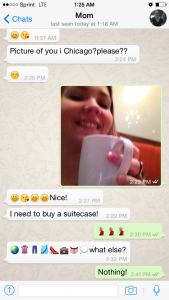Last year, the DRC fellows and I got the opportunity to work with over 20 scholars and students across the country as we put together the DRC’s blog carnival: Beyond a ‘Single Language/Single Modality’ Approach to Writing. Prompted in part by Selfe and Horner’s recent call to put translinguality and transmodality in dialogue, this blog carnival provides a space for the DRC community to discuss, learn from, and value the benefits of blending and layering languages and modes to make meaning. In this post, I’d like to both reflect on the contributions to this blog carnival and to highlight how multilingualism has and continues to be a powerful technology and rhetorical strategy.
Multilingualism as Technology: Listening to Mami
Like most things I’ve learned, everything I know about language starts with mi mami. Having moved around the world due to her dad’s job and her widespread family, mami learned to speak five languages at various points in her life. Now, while she can still communicate effectively with speakers of English, Spanish, German, French, and Portuguese, she very rarely speaks or signs in one language alone. You see, if my mom wants to get her point across, she will not let any language stop her.

Mami will use many of the linguistic, tactical, and rhetorical resources she developed as a language crosser to communicate with her audience in any given context. She will snap, clap, whistle, speak, and dance to anyone at the grocery store to describe just how proud she is of her son the football player (no de futbol pero del americano!). If she can’t think of a word in English, she will draw it, using any resources available to help her navigate communicative discrepancies. In many ways, mami is multimodal, often without a computer. And now, thanks to Whatsapp and her recently purchased smart phone, mami always finds the appropriate emoji combo to communicate how she feels when words are limiting or simply unnecessary.

Listening to mami’s language practices (and watching these practices transfer into her use of technology through something as simple as emojis), prompted me to think about the ways multilinguals engage with multimodal composition. For a recent project, I decided to ask multilingual students about the ways they approach multimodality in their writing classrooms (Gonzales, forthcoming 2015). During these conversations, one student, Enrique, provided a rich definition of multimodality as he explained how he made a video for composition class:
“Making the video was hard because, you don’t just have words and pictures, but you also wanna use the beat of the music to get your ideas across”
As Enrique said the word “beat” during this conversation, he moved his shoulders up and down and made waves with his hands. Through this discussion, Enrique used his body and his words to illustrate how he aims to have his audience not only see, but also feel his ideas when watching his video. Though he had never made a video or taken a college writing class before walking into first-year composition, Enrique’s linguistic history had already provided him training in multimodal composition. He knew how to help his audience feel ideas without relying on words. As Alanna Frost and Steven Alvarez emphasize, multilinguals frequently display the rhetorical dexterity we strive to teach in our classrooms.
Building Bridges, Looking Forward
As evidenced by the contributions to this blog carnival (and by the extensive work being done in this area), theoretical connections about language and technology are already enacted not only in our academic journals, but also in grocery stores, communities, and recording studios. As we keep bridging and unpacking theories like translingualism, translanguaging, code-meshing, and/or code mashing, I am increasingly grateful for the opportunity to learn from the many things multilinguals can teach us about the value of writing beyond any single language or mode.
The key remains with listening.

2 Comments
You are genius! I love your writing and love you more :-*
Laura, this is a beautiful, intellectual, and entertaining read. How blessed DRC is to have you. Lift and climb, my friend. Lift and climb.